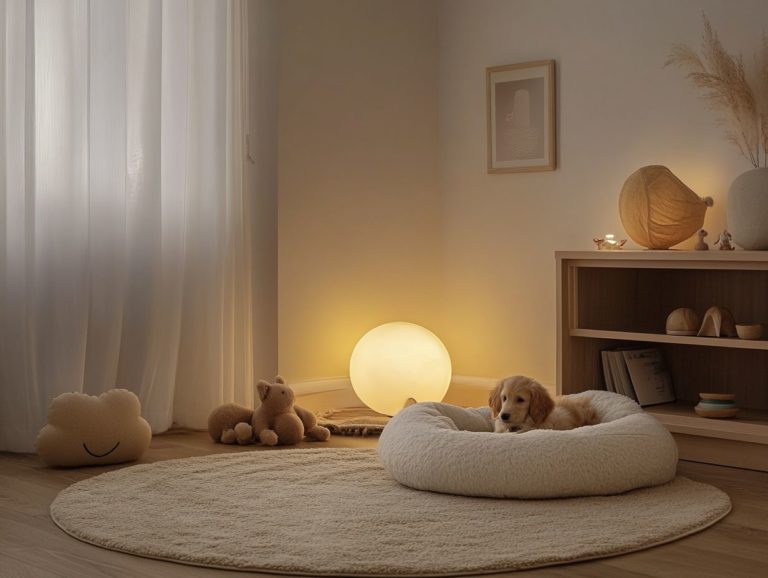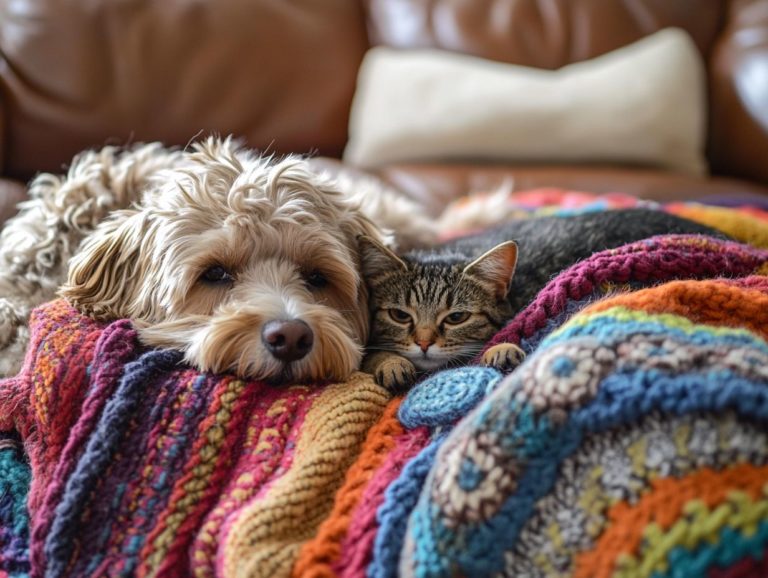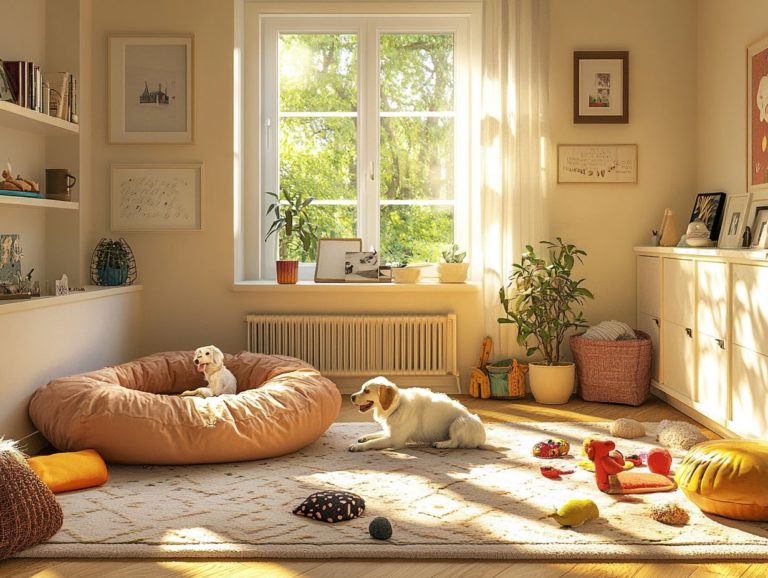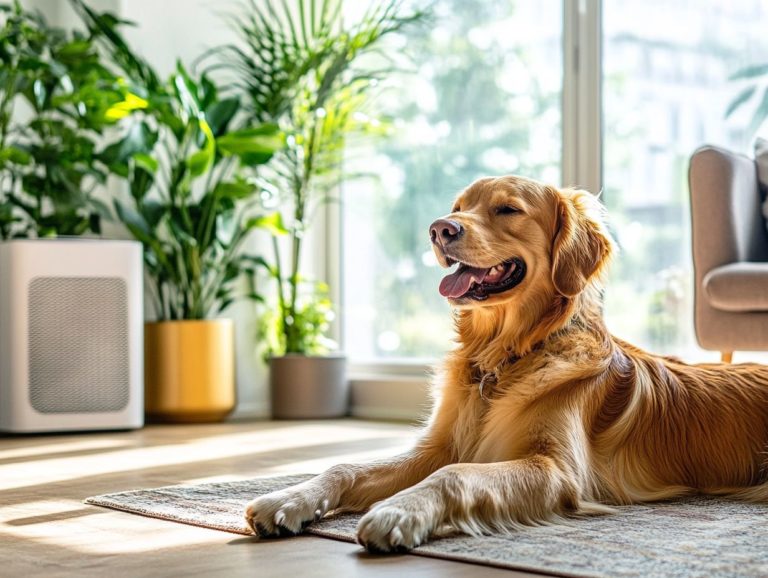5 Essential Changes for a Pet-Friendly Space
Creating a pet-friendly home not only enhances your furry companion s quality of life but also cultivates a harmonious environment for everyone in your space. This allows for cozy spaces to flourish.
By establishing a designated pet area and selecting the right flooring and furniture, you can make meaningful changes that contribute to a more pleasant living experience.
Let s explore five easy ways to transform your home into a safe and inviting sanctuary for your furry friends.
We will cover the benefits not just for your pet but also for your overall mental health. You ll also find tips for seamless introductions, effective maintenance strategies, and common challenges.
Keep reading to discover how to create a joyful haven for your furry friend, considering elements like pet-friendly d cor and interactive toys toys that encourage your pet to play and engage actively.
Contents
- Key Takeaways:
- 1. Create a Dedicated Space for Your Pet
- 2. Choose Pet-Friendly Flooring and Furniture
- 3. Invest in Stain and Odor-Resistant Materials
- 4. Secure Hazardous Areas and Objects
- 5. Incorporate Pet-Friendly D cor and Accessories
- Why Should You Make Your Home Pet-Friendly?
- What Are the Benefits of a Pet-Friendly Space for Your Pet?
- How Can a Pet-Friendly Space Benefit Your Own Well-Being?
- What Are Some Common Challenges of Making a Home Pet-Friendly?
- What Are Some Tips for Introducing a Pet to a New Pet-Friendly Space?
- How Can You Maintain a Clean and Tidy Pet-Friendly Space?
- Frequently Asked Questions
- 1. What are the 5 essential changes for creating a pet-friendly space?
- 2. How can I make my home safe and pet-proof for my furry friend?
- 3. What should I consider when creating a designated area for my pet’s food and water?
- 4. How can I incorporate opportunities for play and exercise in a pet-friendly space?
- 5. What are some easy-to-clean materials that are suitable for a pet-friendly space?
- 6. Can I still have a stylish and aesthetically pleasing home while making it pet-friendly?
Key Takeaways:
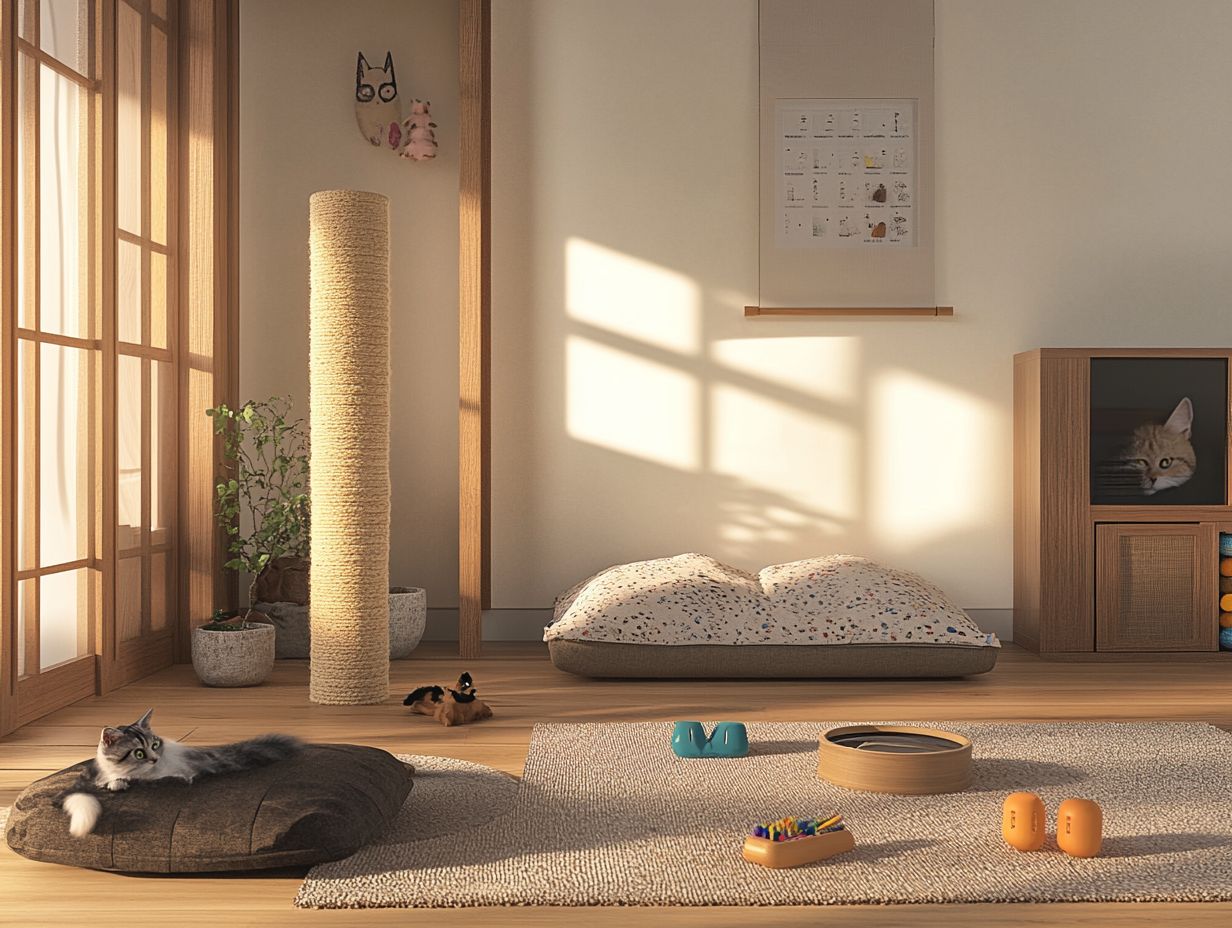
- A dedicated space for your pet creates a sense of belonging and reduces clutter. This enhances pet health and happiness.
- Opt for hard flooring and pet-friendly upholstery to ensure comfort and durability for both you and your furry friend.
- Investing in wipeable wallpaper and stain and odor-resistant materials makes cleaning up after your pet easier and keeps your home smelling fresh.
1. Create a Dedicated Space for Your Pet
Creating a dedicated space for your pet is vital for cultivating a comfortable and safe environment. This space allows your furry companion to have their own sanctuary while enhancing your home’s overall aesthetics. For more ideas, check out how to incorporate comfort items in pet spaces.
This area should reflect your pet’s habits and needs, fully equipped with pet furniture, comfort items, and interactive toys that prioritize their comfort and align with the pet-friendly d cor that Kari Whitman champions.
Establishing this comfort zone benefits both you and your pet, providing a serene sanctuary where you can relax and unwind together.
To elevate this area, implementing pet-proofing strategies like making your home safe for pets, securing loose wires, and opting for durable surfaces is essential for maintaining safety.
Consider investing in stain-resistant textiles:
- Stylish pet beds
- Designated feeding stations
- Storage solutions for toys
Doing so will make the space both cozy and functional. Outdoor living options, soft lighting, and soothing colors can create an inviting atmosphere, ensuring your pets feel secure while you enjoy the seamless blend of practicality and design in your living space. For more tips, check out how to design your home with pets in mind.
2. Choose Pet-Friendly Flooring and Furniture
Selecting pet-friendly flooring and furniture, including options like faux leather and ultrasuede, is essential for achieving both style and practicality in your home.
By doing so, you ensure your living spaces are resilient against the inevitable wear and tear brought on by your furry friends.
Options like wood flooring, tile flooring, faux leather, and ultrasuede are celebrated for their durability and ease of cleaning. They perfectly align with a pet-friendly lifestyle that accommodates both pets and their owners.
Many of these materials come in an array of finishes and colors, including paint finishes, allowing you to find the ideal match for your d cor while still prioritizing functionality.
For example, distressed wood or textured tiles not only effectively conceal scratches and stains but also introduce a rustic charm that enhances any room.
When incorporating these selections, consider using area rugs made from synthetic fibers that are easy to wash, or machine washable options, to blend them effortlessly with furniture designed in similar tones. This creates a harmonious look.
This thoughtful approach not only elevates your home s aesthetic appeal but also ensures it remains a welcoming haven for both family and pets, enhancing pet safety.
3. Invest in Stain and Odor-Resistant Materials
Investing in stain and odor-resistant materials can greatly extend the life of your pet-friendly home, giving you peace of mind while keeping your space fresh and inviting. Consider options like machine-washable covers, eco-friendly materials, and other fabrics that resist stains; they not only safeguard your furniture but also streamline your cleaning routine.
Utilizing materials such as synthetic leather or polyester blends can help repel fur and minimize odors, making it easier for you to maintain a tidy environment. In terms of your floors, think about vinyl or laminate options, which are not only scratch-resistant but can also handle spills from your playful pets, enhancing your pet-safe space.
To keep these surfaces looking their best, regular vacuuming and occasional deep cleans with non-toxic cleaners will prevent the buildup of dirt and odors. Brands like 3M and Scotchgard offer excellent fabric protectors that add an extra layer of defense against stains.
Ultimately, selecting the right materials along with a consistent maintenance routine, including proper pet grooming, ensures a comfortable and welcoming space for both you and your furry friends.
4. Secure Hazardous Areas and Objects
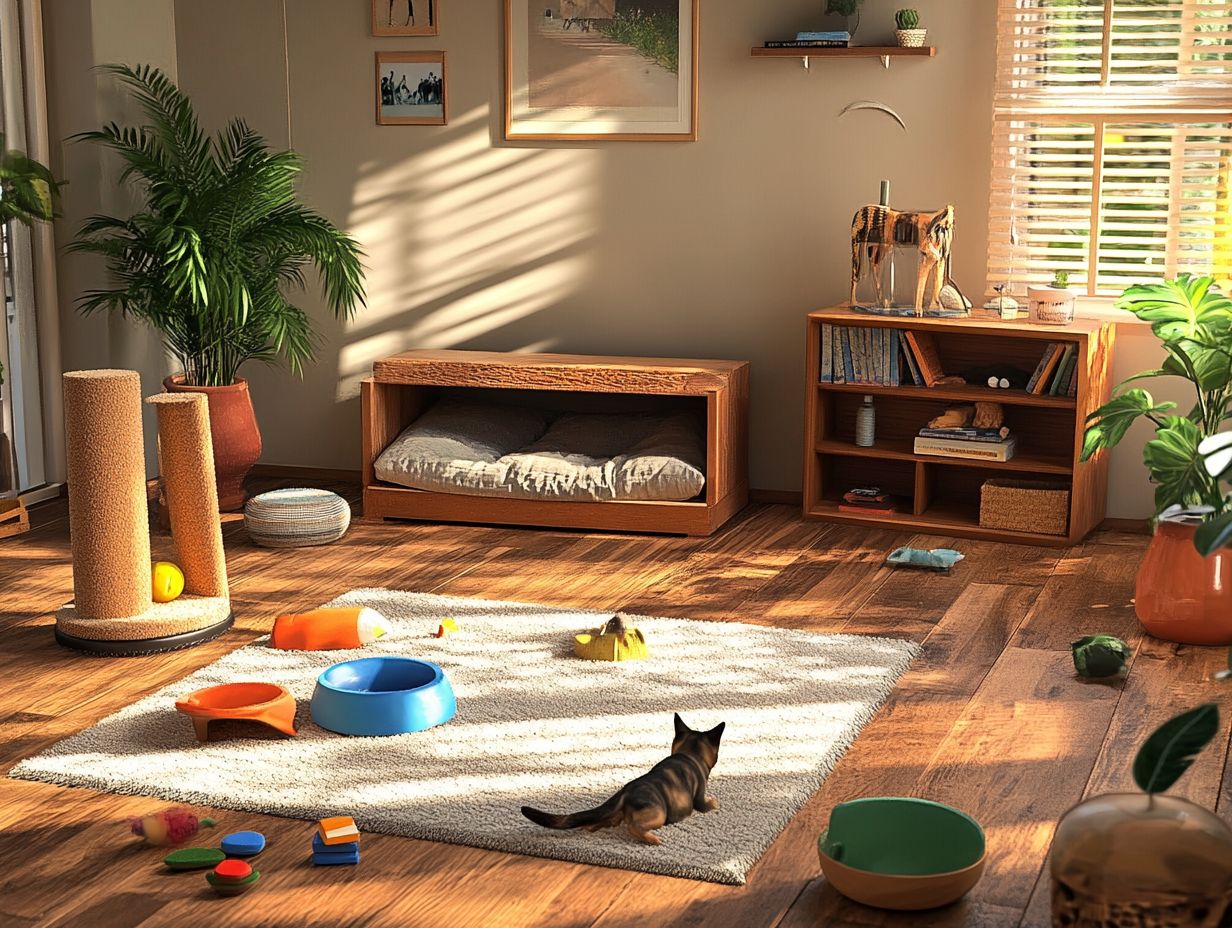
Ensuring your pet’s safety demands careful attention to securing hazardous areas and objects in your home. This creates an environment that minimizes the risk of accidents or injuries. You can significantly enhance your pet-proofing strategy by using pet gates to restrict access to dangerous zones and opting for non-toxic cleaners in your daily routines, prioritizing the health and well-being of your furry companions.
It’s vital to assess the layout of your living space, pinpointing potential hazards such as electrical cords, poisonous plants, or small items that could be easily swallowed. Installing cabinet locks will keep those curious paws away from harmful substances. Properly securing heavy objects and providing safe chew toys can prevent tipping and falling.
Set up fun play zones for your pets that include safe toys and cozy bedding. This not only fosters a secure environment but also encourages their overall well-being. By integrating these thoughtful strategies, including outdoor spaces, you showcase your commitment to a harmonious living space where both pets and humans can thrive together.
5. Incorporate Pet-Friendly D cor and Accessories
Incorporating pet-friendly d cor and accessories instantly brightens up your home and elevates the comfort and well-being of your beloved pets. By thoughtfully integrating elements such as pet-safe indoor plants, comfort items tailored to their needs, and interactive toys that engage their minds, you create a welcoming space that beautifully reflects your love for them, reinforcing their safe space.
Opt for non-toxic plants like spider plants or bamboo palms to infuse a touch of nature into your home without compromising safety. Consider stylish, washable pet beds, furniture covers, or durable, chew-resistant rugs that seamlessly blend with your existing d cor while providing essential comfort for your furry companions.
When it comes to sectioning off areas, choose pet gates that double as decorative elements. This way, you can ensure safety without sacrificing style. Striking a balance between aesthetics and functionality fosters a cozy environment, allowing both you and your pets to enjoy your space in perfect harmony while minimizing noise stress.
Take these steps today to create a safer, happier home for your pets!
Why Should You Make Your Home Pet-Friendly?
Making your home good for pets goes beyond just accommodating your furry friends; it significantly enhances the well-being of both pets and their humans. A thoughtfully designed environment boosts mental health and provides comfort, creating a harmonious space where everyone thrives.
Research shows that pet ownership leads to remarkable health benefits, including lower blood pressure and an uplifted mood. A study by the Human-Animal Bond Research Institute revealed that 74% of pet owners reported improved mental health thanks to their beloved companions, highlighting the connection between pet grooming and overall well-being.
A pet-friendly home encourages physical activity and social interaction, benefiting both pets and their owners. By creating a nurturing environment with available water and safe spaces to play and rest, you support your pet’s health and enrich your own quality of life.
What Are the Benefits of a Pet-Friendly Space for Your Pet?
A pet-friendly space brings many benefits for your furry friend, from boosting their mental health to providing a secure, comfortable environment. By following 5 steps to create a relaxing pet environment, and integrating elements like designated comfort zones and safe chew toys, you create an atmosphere that fosters safety and well-being.
In this environment, your pets find physical comfort and psychological enrichment, leading to reduced anxiety and stress levels. Designing spaces with your pet’s needs in mind is key; for example, creating areas for social interaction encourages positive behaviors and strengthens emotional bonds.
Adding cozy resting spots and safe floors enhances safety and comfort. Therefore, considering the dos and don’ts of pet space design is crucial for nurturing a happy and healthy companion.
How Can a Pet-Friendly Space Benefit Your Own Well-Being?

Making your space pet-friendly not only makes your pets happier but also boosts your mood! The presence of pets fosters a relaxed atmosphere, and comfort items promote bonding, bringing happiness to both you and your furry companions.
Shared areas with cozy blankets and play zones become havens for joyful moments that can significantly lift your mood. Engaging in play or enjoying the companionship of your pet releases oxytocin, a hormone associated with emotional connection, naturally elevating your spirits.
The constant presence of a furry friend offers invaluable companionship that counters loneliness, making each day feel more fulfilling. By creating an environment that prioritizes the needs of both you and your pet, you can unlock deeper emotional connections and experience a profound sense of peace and contentment.
What Are Some Common Challenges of Making a Home Pet-Friendly?
Designing a pet-friendly home can be incredibly rewarding. However, it comes with unique challenges, such as constant maintenance and managing stress related to cleanliness and organization. To help create a more comfortable space, consider these 5 ways to create a cozy corner for pets.
Making your home safe for pets may feel daunting. You’ll need to carefully consider the cleaning products you use and how they affect both your d cor and your pets health.
As a pet owner, you navigate the tricky terrain of choosing furniture that withstands claws and shedding fur. Selecting durable materials is essential.
The layout of your living space also presents challenges. Keeping pathways clear and treasured items out of reach can help prevent accidents and damage.
There are simple solutions to try. Consider using slipcovers that are easy to wash and placing mats to catch fur and debris. Training your pets to respect certain areas can foster a harmonious atmosphere and strengthen your bond.
What Are Some Tips for Introducing a Pet to a New Pet-Friendly Space?
Introducing a pet to a new space requires planning, especially when it comes to making it pet-friendly. Creating specific spots for your furry friend, providing comfort items, and ensuring a safe environment can ease their transition. For more tips, check out this guide on how to set up a pet-friendly living room.
Let your pet explore at their own pace, starting with familiar scents and toys. This helps them connect to the new space.
Maintaining a routine similar to what your pet is used to establishes a sense of normalcy amid the changes. Keep in mind that patience is key to helping your pet settle in.
How Can You Maintain a Clean and Tidy Pet-Friendly Space?
Maintaining a clean and tidy pet-friendly space is vital for everyone s health and happiness. It requires a solid strategy to manage stains, odors, and everyday messes.
By using stain-resistant materials, machine-washable items, and eco-friendly cleaning products, you streamline the cleaning process and create a hygienic environment.
Set up a regular deep-cleaning schedule to tackle often-overlooked areas like carpets and upholstery. Consider using vacuum cleaners with HEPA filters to capture allergens.
Using pet-specific cleaning solutions helps address the unique messes pets create, ensuring every corner of your home remains fresh.
Frequently Asked Questions
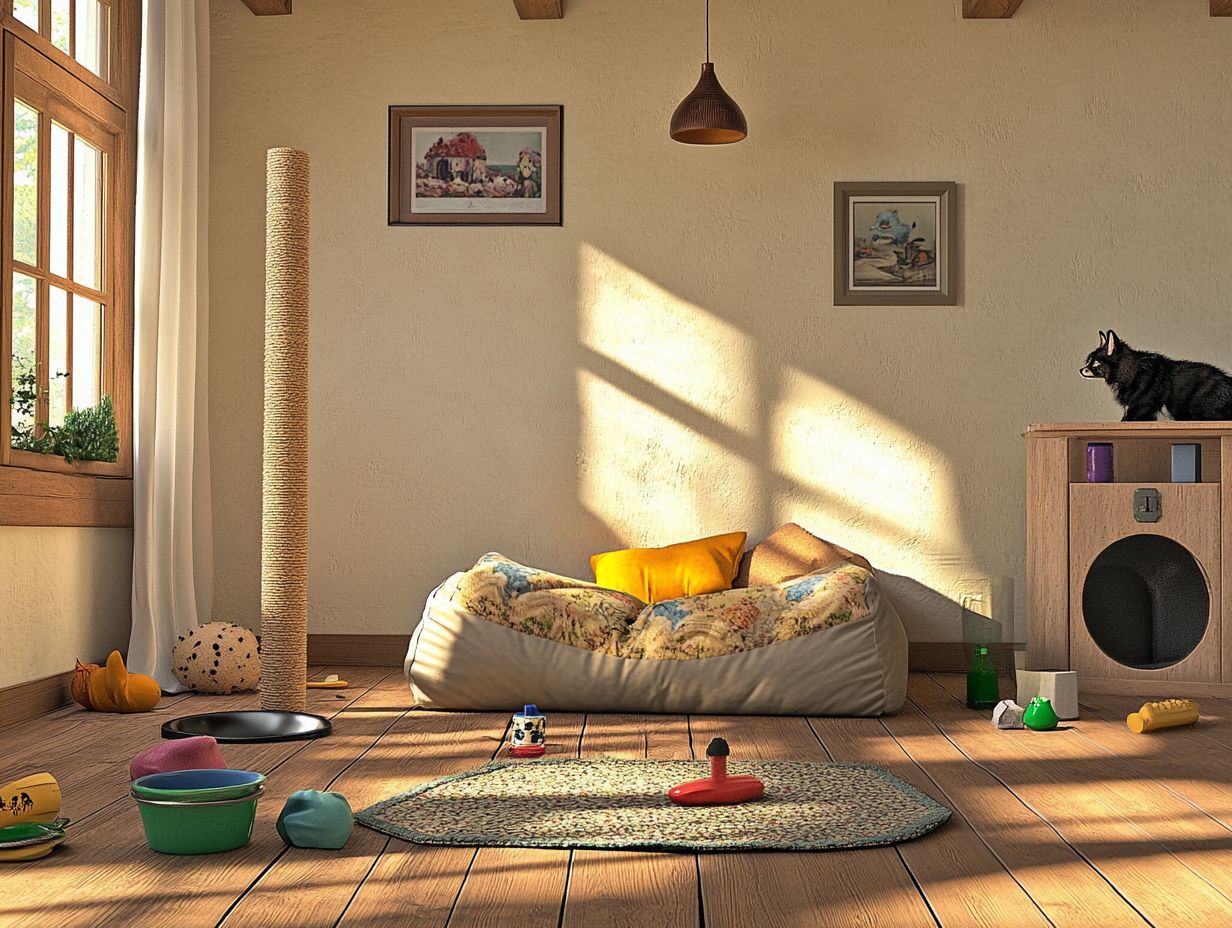
1. What are the 5 essential changes for creating a pet-friendly space?
The five essential changes are cozy sleeping areas, safe and pet-proof spaces, designated food and water spots, play and exercise opportunities, and must-have items for pet-friendly spaces that feature easy-to-clean materials.
2. How can I make my home safe and pet-proof for my furry friend?
Make your home safe by securing cords, removing toxic plants, storing cleaning supplies out of reach, and closing off hazardous areas.
3. What should I consider when creating a designated area for my pet’s food and water?
Choose a quiet and accessible spot for your pet’s food and water. Use non-slip bowls and keep the area clean to prevent spills.
4. How can I incorporate opportunities for play and exercise in a pet-friendly space?
Make playtime exciting! Add toys and create a fun play area where your pet can move freely.
5. What are some easy-to-clean materials that are suitable for a pet-friendly space?
Consider using hardwood or laminate flooring. Opt for washable fabrics for furniture and wipeable surfaces for countertops.
6. Can I still have a stylish and aesthetically pleasing home while making it pet-friendly?
Absolutely! You can add stylish elements, like pet-friendly furniture and decor. Choose durable materials and keep your space organized.

